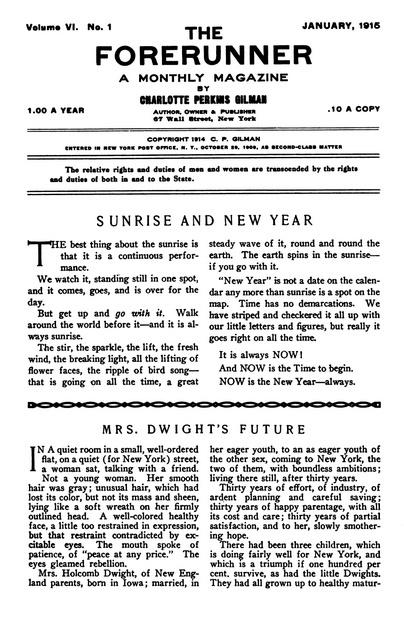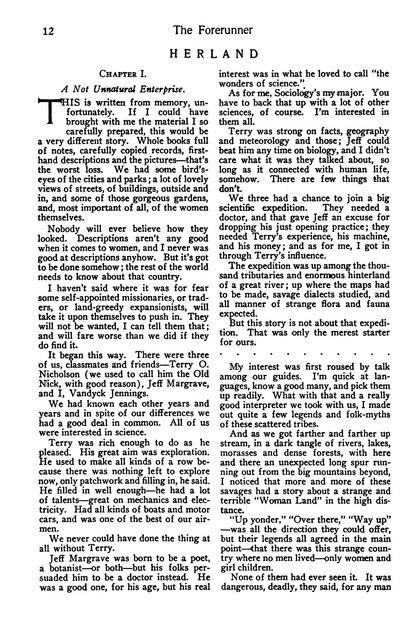Book review by Mary P: When we were given the choice between utopian and dystopian fiction this month, I immediately went for the former. During the lockdown from Covid 19 and all the discussion about how things will be different when it is all over, it seemed appropriate to look at how others have imagined the world might be.
Charlotte Perkins Gilman published the first of her utopian trilogy in 1915. It was published in monthly instalments in a magazine that she edited and wrote for. It was largely forgotten about until it was republished in 1979, when there was a resurgence of interest by contemporary women writers in feminist science fiction writing.
 First page of the january 1915 edition of Gilman’s magazine The Forerunner, in which Herland first appeared.
First page of the january 1915 edition of Gilman’s magazine The Forerunner, in which Herland first appeared.
Gilman writes in the voice of Vandyke Jennings. He and his two companions are on an expedition, and in the course of their explorations in an unspecified place, they hear about a land where only women live. They agree to return alone in the future to find it, and call it Herland. They speculate on the journey about what they will find, showing their take on issues of gender.
‘ They would fight amongst themselves…Women always do. We mustn’t look to find any sort of order and organisation. ‘
‘ It will be like a nunnery under an abbess – a peaceful harmonious sisterhood. ‘
They finally reach Herland by boat and plane.
‘Everything was beauty, order, perfect cleanliness, and the pleasantest sense of home over it ‘
They walk through a forest, and notice they are being followed by three women. Terry attempts to lure them with trickets he has bought with him. Shades of colonial expeditions bringing beads to the natives. When they arrive in a village they are corralled by the women and when Terry tries to break free they are anaesthetised.
Imprisoned in a fortified building they are given tutors and books to learn the language and culture, and to teach about their own. Terry in particular finds the imprisonment tough and they escape only to find their plane has been wrapped in a material that they are unable to break into, and they are returned to their former imprisonment.
They gradually learn more about Herland and its history. 2,000 years ago decimated by war, with many of the men killed they retreated to a land that had natural defences. The polygamous, slave holding culture was cut off from the outside world when a volcanic eruption blocked the passes. The slaves rose up and killed their masters, and in turn were killed by the women inhabitants. This women only land evolved gradually , finding that through parthenogenesis each woman was able to bear five daughters. Gradually the population grew larger than the land could sustain, and motherhood was limited to those who were thought to be the most fit to have daughters. Thus what were seen as weaknesses are bred out. Motherhood is a shared task in which all women are involved. Cooperation, and equality are the central tenets of Herland. Everything is considered in the context of what will be best for the future wellbeing of all the population.
The women ask questions about the world outside. The narrator gradually finds how hard it is to defend his way of life. Terry blusters, and continues to be closed off to thinking through what he is being exposed to.
The three men grow close to the three women that they first saw when they arrived. They pair off and have a marriage ceremony. The women continue to live separately, and the men adjust to a new sort of relationship. Terry who is an entitled man struggles most with this, and when he rapes his partner the women decide the men must leave. Jeff whose wife is pregnant elects to stay, and the narrator leaves with his partner and Terry and they are sworn to secrecy about the whereabouts of Herland.
There are a number of themes explored in the book. Motherhood is at the very center of Herland. It is a shared task, and there is no concept of a personal attachment to biological daughters. When the men discuss motherhood in their society the women are appalled at the idea of abortion. Women are mystical earth mothers, and the future of their daughters and their education and wellbeing is the central role for all women.
Issues of gender are explored through the device of creating this ‘Lost World’, and contrasting the two cultures. Gilman is clearly creating in Herland the world that she would like to be part of, and her dialog with those who would disagree is played out through the thoughts of the three male characters. They are rather caricatures of masculinity. Terry, women are to be conquered and subdued, Jeff, women are to be protected , and Van, women are to be learned from.
These themes together with exploration of the individual versus the collective are very relevant to the contemporary reader, and make Herland worth reading today. Fiction is a good way of considering such big issues. Writers such as Doris Lessing, and Margaret Atwood have used fiction similarly. Of course Herland is of its time, and shows attitudes regarding race, and gender that contemporary readers are not so comfortable with. However it is still of interest, and its republication suggests that it is seen as important in the history of feminist ideas.
Herland is short, but despite this I did find that my interest flagged as the book went on. For me there was a bit too much telling me how things worked there, rather than showing me through the interaction of the characters and the story. After the adventure story beginning, it did rather end up in being a treatise on one particular view of a feminist utopia. All a little too bland for my comfort. Nothing goes wrong in this world. The weather is never bad, and the crops don’t fail. No one rebels, and chaos is always kept at bay. But perhaps I feel like that because I am living through my own world turned upside down, and certainties suddenly feeling less so!
 The first page of Herland, , as it appeared in The Forerunner, 1915.
The first page of Herland, , as it appeared in The Forerunner, 1915.
